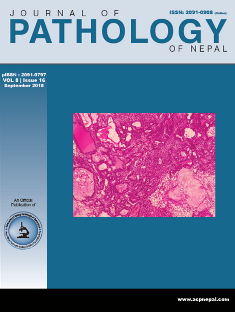A histopathological study of granulomatous lesions
DOI:
https://doi.org/10.3126/jpn.v8i2.20863Keywords:
Epithelioid, Fungus, Granuloma, Histiocyte, TuberculosisAbstract
Background: Granulomas are the commonest lesions that the pathologists come across in routine practice. Granulomatous inflammation is a special type of chronic inflammation that is a manifestation of many infective, toxic, allergic, autoimmune and neoplastic diseases and also conditions of unknown etiology. The aim of this study is to analyze different granulomatous lesions and to find the frequency and etiology of all granulomatous lesions.
Materials and Methods: The study included a total of 218 granulomatous lesions, received over a period of one year from July 2013 to June 2014 in the department of pathology, TUTH. Special stains like Ziehl-Neelsen, PAS and Wade- Fite- Faraco were done whenever required.
Results: Granulomatous lesion accounted for 3% of all biopsies. The median age of the patients was 29 years and the majority of the patients were in the age group of 20-29 years with no sex predilection. Majority of granulomas were seen in lymph nodes (32.1%), followed by skin and subcutis (29.4%), and bones and joints (11%). Tuberculosis was the most common cause of granuloma with 143 (65.6%) cases, followed by leprosy, foreign body and fungal infection. The most common type of granuloma was epithelioid (87.2%), followed by epithelioid with suppuration, histiocytic, foreign body and mixed inflammatory.
Conclusion: The granulomatous lesion is common in third decade of life with no sex predominance. The commonest site is lymph node with tuberculosis being the most common cause followed by leprosy. The epithelioid type was the most common type of granuloma.
Downloads
Downloads
Published
How to Cite
Issue
Section
License
This license enables reusers to distribute, remix, adapt, and build upon the material in any medium or format, so long as attribution is given to the creator. The license allows for commercial use.




